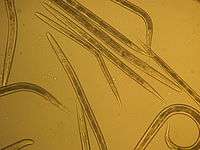Panagrellus redivivus
The free-living nematode Panagrellus redivivus (common names include vinegar eel, vinegar eelworm, vinegar nematode, paste worm, starch worm, sour paste nematode, sour paste eelworm, beer felt nematode, and beer mat nematode[1][2]), is a tiny nematode that can be found living in beer mats, insect frass, slime from tree wounds, wheat paste, and mother of vinegar.[1] Their environment makes them exceptionally tolerant of variation in acidity and alkalinity and they may be able to tolerate a wider range than any other nematode species, being able to survive from pH 1.6 to 11.[3] One of thirteen currently recognized species of Panagrellus, P. redivivus is about 50 μm in diameter and just over 1 mm in length, barely visible to the naked eye. Subsisting on yeast, it is easily cultured at home on a substrate of flour paste[4] or porridge inoculated with dry yeast.[5] Females reach maturity in about three days and deliver live young rather than eggs, as most nematodes produce.
| Panagrellus redivivus | |
|---|---|
 | |
| Observation of Panagrellus redivivus on a Zeiss microscope stage | |
| Scientific classification | |
| Kingdom: | |
| Phylum: | |
| Class: | |
| Order: | |
| Family: | Panagrolaimidae |
| Genus: | Panagrellus |
| Species: | P. redivivus |
| Binomial name | |
| Panagrellus redivivus (Linnaeus, 1767) | |
| Synonyms[1] | |
| |
Pisciculture
P. redivivus is known to many aquarium enthusiasts and fish keepers as the microworm. It is a tiny roundworm used as the first food for larger kinds of newly-hatched fish, such as larval common carp.[6][7] The microworm is widely used in aquaculture as food for a variety of fish and crustacean species.[8][9]
Model organism
The microworm has been used as a model organism in genetic analysis studies, but not nearly as universally as its relative, Caenorhabditis elegans.[10]
Occurrence in food
In Vietnamese cuisine, cơm mẻ[11] is an ingredient which appears in many dishes such as buffalo meat[12] and fish soup[13] thanks to its sourness. Cơm mẻ is the cooked rice being lactic fermented by yeast and maintained with the existence of P. redivivus. Although they are harmless and non-parasitic, leaving eelworms in vinegar is considered objectionable in the United States and is not permitted in vinegar destined for American consumers.[14] Manufacturers normally filter and pasteurize their product prior to bottling, destroying the live bacterial and yeast culture that these nematodes require for sustenance.
References
- Ferris H. (2009). "The beer mat nematode, Panagrellus redivivus: A study of the connectedness of scientific discovery" (PDF). J. Nematode Morphol. Syst. 12 (1): 19–25.
- Stock S, Nadler, N. (2006). "Morphological and molecular characterization of Panagrellus spp. (Cephalobina: Panagrolaimidae): Taxonomic status and phylogenetic relationships" (PDF). Nematology. 8 (6): 921–938.CS1 maint: uses authors parameter (link)
- Schulze-Makuch, Dirk; Irwin, Louis Neal (2008-10-02). Life in the Universe: Expectations and Constraints. Springer Science & Business Media. p. 57. ISBN 9783540768166.
- Linnaeus identified the species in library or book paste.
- Worm Culture Information
- Schlechtriem, C., M. Ricci, U. Focken and K. Becker (2004). "The suitability of the free-living nematode Panagrellus redivivus as live food for first-feeding fish larvae". Journal of Applied Ichthyology. 20 (3): 161. doi:10.1111/j.1439-0426.2004.00542.x.CS1 maint: uses authors parameter (link)
- "The Chesapeake Area Killifish Club: Vinegar Eels". www.chesapeakekillifish.org. Retrieved 2019-01-19.
- "Vinegar Eels". web.archive.org. 2012-02-22. Retrieved 2019-01-19.
- Sautter J., Kaiser H., Focken U., Becker K. (2007). "Panagrellus redivivus (Linné) as a live food organism in the early rearing of the catfish Synodontis petricola (Matthes)". Aquaculture Research. 38 (6): 653–659. doi:10.1111/j.1365-2109.2007.01714.x.CS1 maint: uses authors parameter (link)
- Kovaleva, E.S.; et al. (2003). "Panagrellus redivivus as a molecular model for cyst nematodes". Journal of Nematology. 35 (3): 348.
- "Cách Làm Cơm Mẻ thơm ngon không lo mốc chỉ 2 bước đơn giản". Cooky.vn (in Vietnamese). Retrieved 2018-08-17.
- "Cách làm món thịt trâu nhúng mẻ nóng hổi cực ngon". Cungbanvaobep: Món Ngon Mỗi Ngày - Ẩm Thực - Nấu Ăn. 2015-11-20. Retrieved 2018-08-17.
- "Cách nấu canh chua cơm mẻ ngon mê ly cho ngày tiết trời ẩm ương". ameohay.com. Retrieved 2018-08-17.
- "FDA: Sec. 525.825 Vinegar, Definitions - Adulteration with Vinegar Eels (CPG 7109.22)". fda.gov. Retrieved 26 September 2018.